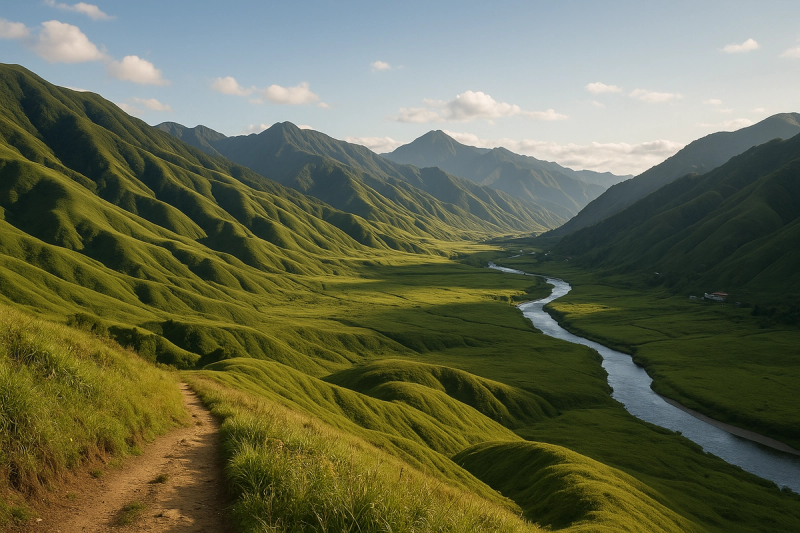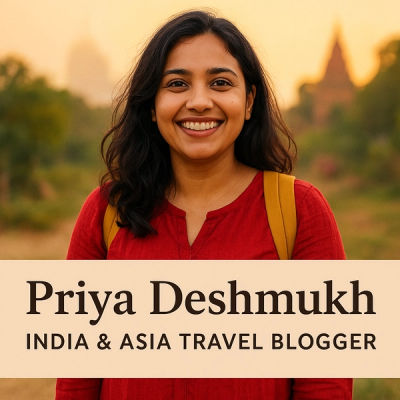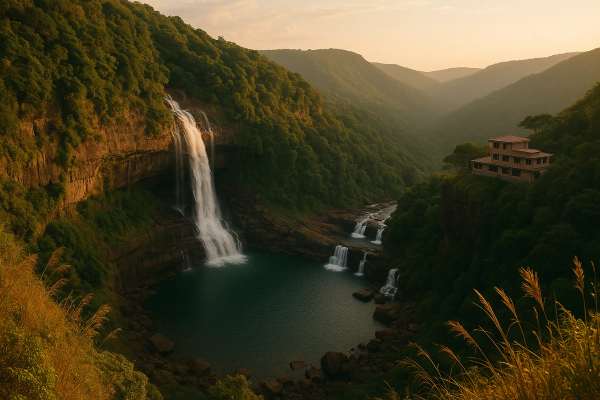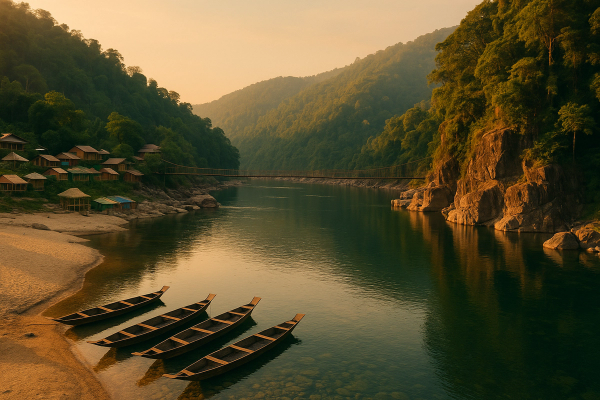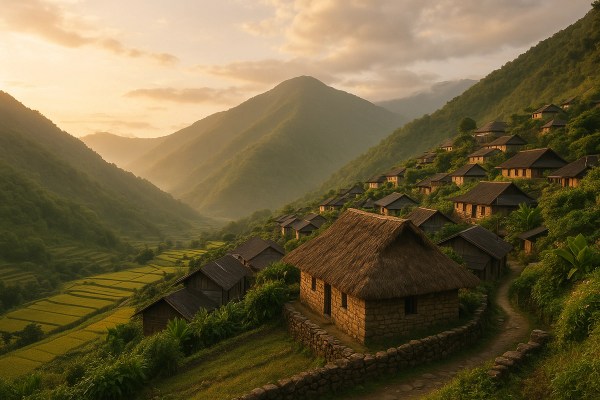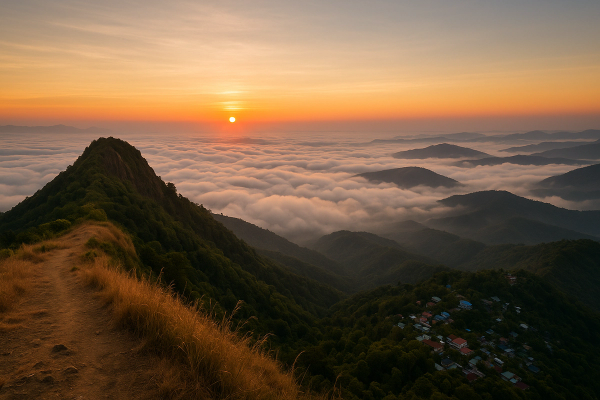Top 7 Treks in Northeast India (Dzukou–Mechuka): a very real, slightly messy guide you’ll actually use#
If you’re the kind who packs off first and googles later (me too, guilty), Northeast India is where your heart will basically start living rent-free. Forests that smell like rain, bamboo trails that make your knees shake, monasteries perched like whispers on hills… and treks that swing from mossy jungle to proper Himalayan high. I’ve put together a guide that feels like chatting with a friend on a tea-stall bench—full of small hacks, prices that don’t suck, honest notes on permissions and safety, and a little emotion because how can you not. I won’t oversell the year, but the on-ground info is updated for now—permits, road conditions, homestays, best months. Pack light, walk slow, leave the mountains cleaner than you found them.¶
Quick heads-up before you lace up#
Permits first: Arunachal needs an Inner Line Permit (ILP) for Indians (apply online, cheap—around ₹100–₹200 plus service fee), foreigners need a Protected Area Permit. Nagaland has ILP too, and Manipur introduced ILP in recent years—so don’t just show up, ok? Check official state portals; they’re not fancy but they work. Safety: the region’s super welcoming, but weather flips fast, landslides happen, and network’s patchy (Jio works in some valleys, BSNL stubbornly refuses to die). Cash still matters in interior places, even now. And btw, Meghalaya’s been pushing plastic-free strongly—carry your bottle, don’t dump sachets. A lot of treks now insist on local guides (or at least recommend)—not just a rule thing, but maps don’t show cattle tracks, and villagers know which stream’s drinkable and which isn’t.¶
1) Dzukou Valley Trek, Nagaland/Manipur – that grassy bowl of dreams#
Dzukou is the poster child: rolling meadows, milky streams, flowers that come alive after rains. Most folks start from Jakhama or Viswema near Kohima. The climb’s short but steep, then it evens out onto a plateau that looks like some giant plopped down a green duvet. Best months? Post-monsoon (September to November) for crisp skies; winter gets chilly and sometimes snowy. Monsoon (June–August) is peak bloom, but trails can get slippery—your shoes will die a noble death. ILP required for Nagaland. At the valley there’s a very basic rest house, a few sheds—carry your sleeping bag unless you’re cool with rough blankets. Budget: Kohima hostels ₹600–₹1200; valley stay ₹300–₹700; food simple (rice, dal, eggs, maggi, tea). Phone network: mostly nope. Take cash. Small tip—start early, the sunrise turns meadows into gold sheets; you’ll cry a little and pretend it’s just the wind.¶
Tiny hacky details: From Kohima you can grab a shared taxi to Jakhama/Viswema for around ₹150–₹300. Trail markers exist but fog loves drama, so ask locals at the entry gate for exact current path. Water’s clean near the valley streams, still purify if you can. Don’t wander too far after dark, the valley looks friendly but Mist + Ravines = you don’t wanna test that combo. If you’ve time, Japfu Peak (the tallest in Nagaland) is a worthy detour—there’s that ancient giant rhododendron tree nearby and views aren’t shy.¶
2) Mechuka Valley Trek, Arunachal – wooden monastery, funny winds, and Yargyap Chu singing along#
Mechuka’s like a mural—pastel houses, grazing horses, river shining like glass. Base yourself in Mechuka town and plan day hikes: the old wooden Samten Yongcha Gompa on the hill, long walks across suspension bridges, and meadow loops towards Segong. The altitude’s moderate (~1800–1900 m), but weather turns from sunshine to snarky drizzle in an hour. Best season: October to April for clear skies; summer’s nice but can be rainy. Reach via Dibrugarh/Pasighat–Aalo–Mechuka road (long but scenic), or check current helicopter services (they exist sometimes, not always predictable). ILP for Arunachal is mandatory; get it done online before you travel. Homestays are the vibe—₹1500–₹3500 per room with hearty meals. Food: thukpa, momos, smoked pork, chhurpi, and apong (local rice beer) if you want to unwind. Network: patchy. Cash: yep. Respect army check-posts, don’t fly drones near borders, please don’t be that person.¶
Pro notes: Weatherproof your daypack—river spray and sudden rain is a thing here. A local guide for longer hikes is worth it (₹1500–₹2500/day), and porters are available for multi-day routes if you’re exploring beyond Mechuka. Ask about the Mechuka Adventure Festival—when it runs (typically in late autumn), it’s a nice peek into local culture. Also, mornings are blue-pale and quiet; walk down to the river, sit by the stones, have your tea, you’ll feel time get very slow.¶
3) Goecha La (Viewpoint 1) via Dzongri, Sikkim – big mountains, bigger feelings#
This one’s not a "just show up" trek. Start at Yuksom, go via Sachen–Tshoka–Dzongri–Thansing–Lamuney, and you’ll approach the famous Goecha La viewpoint (usually Viewpoint 1 is the allowed turn-around these days), with Kangchenjunga looming like a wall of moonlight. Best months: April–May for rhodo bloom; October–November for crystal views. Permits: entry to Khangchendzonga National Park plus trek permission—Indian citizens can get it at Yuksom; foreigners need PAP for Sikkim. Camping is now strictly at designated sites to protect the fragile ecology, and you’ll see plastic-bottle bans enforced. Guides/mules: common and honestly a good idea—for the trail, load carrying, and local economy. Costs: Yuksom stay ₹1000–₹2000; trekking guide ₹1500–₹2500/day; mule charges depend on load, usually ₹1000–₹1600/day. Altitude gets real past Dzongri, so go slow, drink soup, accept that headaches are stubborn.¶
Trail feels: Moss forests, wooden bridges, black tea at Tshoka with biscuits that crumble at the worst moment, then that sunrise at Dzongri where everything turns pink-orange. If weather shuts down, don’t push. It’s ok to turn back—you’ll return for another try, and the mountain won’t mind. Pack a power bank, though many camps have solar lights now; network’s basically gone the moment you leave Yuksom. From Bagdogra or Pakyong airport, hire a shared cab to Gyalshing/Yuksom (₹600–₹1200 per seat depending on your bargaining mood and season).¶
4) Nongriat Double-Decker Root Bridge + Rainbow Falls, Meghalaya – stairs, sweat, and that electric-blue water#
Meghalaya trekking hits different because it’s rainfirst. The iconic Double-Decker Root Bridge at Nongriat is reached by a stair descent from Tyrna—roughly 3500 steps that will make your thighs write resignation letters. The village stay is simple, lovely, and from there you can push to Rainbow Falls where the pool looks like it swallowed the sky. Best months: October–April for stable paths; monsoon June–September is insane-green but slippery, so careful. No ILP needed for Meghalaya, but there are eco-rules—carry out your trash, metal bottles only, avoid playing music on speakers in the forest. Homestays ₹500–₹1500 depending on room/dorm; local food like jadoh (rice with meat), dohneiiong (pork with black sesame), tungrymbai (soybean) is what you eat when you’re hungry, happy, and slightly muddy.¶
Getting there: From Shillong, shared sumos to Cherrapunjee/Sohra (₹100–₹200), then local taxi to Tyrna. It’s a one-hour-ish descent to Nongriat; return climb is exactly as painful as Instagram doesn’t tell you. Pack knee support, rain jacket, and keep your slippers for the streams only—hike in proper shoes. Trend update: the Mawryngkhang bamboo trail near Wahkhen is back in shape with repairs, but always ask locals at the gate about current condition before you balance on those skywalks like you’re a mountain goat.¶
5) Mount Saramati, Nagaland – tall, remote, and a little wild#
Saramati (around 3826 m) sits near the India–Myanmar border and is a proper offbeat climb. Most folks start from Thanamir Apple Village in Kiphire district. Day 1 gets you through dense forest to a camping meadow; Day 2 pushes steeply to the summit ridge with views that look fake. Permits: check with Kiphire district administration and village council; a local guide is pretty much mandatory and very wise. Best months: October–November post-monsoon or March–April before the heavy rains. Homestays in Thanamir ₹1000–₹2000, simple meals, warm hospitality. Safety: bears are rare but reported sometimes, and you’ll see wild boar signs—don’t leave food outside tents. Network: basically no. Cash, headlamp, and calm—carry all three.¶
Gear tip: A proper rainfly for your tent and a solid trekking pole helps on the muddy sections. Saramati is less about crowds and more about being okay with silence and seeing distant villages twinkle at night. People here will share stories over tea and axone-pork, and you’ll pretend you didn’t just burn your tongue because it’s too good.¶
6) Shirui Peak, Manipur – lilies, clouds that spoon the hills, and Tangkhul warmth#
Shirui is gentle compared to Himalayan giants but beautiful, especially when the rare Shirui Lily blooms (typically May–June, though the exact window depends on the rains). Base in Ukhrul town and go early to beat crowds. ILP applies in Manipur; check online and carry a few copies because sometimes random checkpoints ask. Safety note: always check the latest travel advisory for Manipur—it’s been complicated in recent times, though Ukhrul and day treks are usually calm. Homestays ₹800–₹1800; food is hearty—eromba (mashed veggies with fermented fish), ngari flavors, black rice pudding if you get lucky. Path is soft, fog rolls in fast; pack a light rain jacket, don’t wander off trail.¶
Local add-on: visit a village craft center for Longpi pottery (serpentinite stoneware that’s gorgeous), buy responsibly, and carry back small stuff only. Shared sumos run from Imphal to Ukhrul; book early on weekends. The ridge views when the clouds lift? That sweet, quiet happiness that sits in your chest and refuses to move.¶
7) Namdapha Rainforest Trek (Miao–Deban–Hornbill circuits), Arunachal – leeches, old trees, very alive#
Namdapha is a different planet—tall dipterocarps, gushing rivers, birds everywhere, and a trek that’s less summit-chasing, more jungle immersion. Most base at Deban Forest Rest House; routes range from day hikes to multi-day pushes towards hornbill habitats and deeper camps. Permits: you need entry permission from Namdapha NP authorities at Miao; local guides are essential (Lisu community porters know the forest). Best months: November–March for lower leech levels and less rain. Costs: FRH rooms vary (₹800–₹2000), guides ₹1500–₹2500/day, porters similar. Gear: leech socks, gaiters, strong repellent, water purification—don’t skip. Network: mostly none. You’ll listen to the forest’s heartbeat and realize how noisy cities are.¶
Practical: From Dibrugarh or Lilabari you can reach Miao via bus/cab (budget around ₹1000–₹3000 depending on your bargaining luck). Keep emergency meds dry, carry laminated ID copies, and tell the range office your route. Some stretches have elephants—locally guided timings matter. It’s respectful to dress modestly in villages, ask before photography, and offer to carry back extra trash if you see some—tiny good deeds make big differences out here.¶
Money, stays, and transport—real numbers so you can plan without crying#
- Homestays: ₹800–₹3500 per room depending on location/season; dorms (Meghalaya/Nagaland hill towns) start ₹300–₹800.
- Local guides: ₹1200–₹2500 per day; porters around ₹1000–₹2000 per day—set expectations clearly (load, distance, food included?).
- Shared sumos: ₹100–₹600 for town-to-town hops; long routes (Aalo–Mechuka, Imphal–Ukhrul) can go ₹800–₹1500.
- Permits: ILP (Arunachal/Nagaland/Manipur) ~₹100–₹200 plus online fee; park entries ₹50–₹300, sometimes camera charges extra.
- Food: Simple hot meals ₹120–₹300 per plate; tea ₹20–₹40 (unlimited if you smile and chat, sometimes). Carry snacks from bigger towns—prices spike deep inside.¶
When to go (season cheatsheet that actually helps)#
- Post-monsoon (Sept–Nov): crisp skies, green everywhere, great for Dzukou, Mechuka, Saramati.
- Winter (Dec–Feb): cold but clean views; snow chances in higher locales; pack layers and proper sleeping bag.
- Spring (Mar–May): rhododendrons in Sikkim, lilies in Shirui, comfortable temps.
- Monsoon (Jun–Sep): Meghalaya is magic but slippery; jungle treks get leechy; landslides possible. Go only if you love rain and have backup days.¶
Food that tastes like the hills and rain#
I’m not even pretending to be neutral here. Northeast food is comfort. Try smoked pork with bamboo shoot (Nagaland), axone (soybean fermented; smell strong, taste stronger), thukpa/momos (Arunachal & Sikkim), jadoh and dohneiiong (Meghalaya), eromba and black rice desserts (Manipur). Chhurpi (hard cheese) for long treks, sticky rice for warmth, and apong/chhang to toast the day. Eat local, say thank you in the language if you can, and don’t waste—villages carry supplies uphill and it’s hard work.¶
Lesser-known add-ons if you’ve extra days#
- Japfu Peak from Kohima for a sunrise that makes people quiet.
- Sangti Valley near Dirang (Arunachal) for slow riverside walks and black-necked cranes in winter.
- Mawryngkhang bamboo trail near Wahkhen (Meghalaya) if you want vertigo and bragging rights.
- Barsey Rhododendron Sanctuary (West Sikkim) for a chill forest trek when flowers are on.
These aren’t hard-core multi-day always, but they add texture to your trip. Mix them in if your knees and timeline agree.¶
Responsible trekking (yes, the serious stuff you shouldn’t skip)#
- Pack in, pack out: take your trash back, always.
- Don’t blast music: forests aren’t your living room.
- Ask before photos: people’s faces aren’t souvenirs.
- Stay on trail: shortcuts kill roots and cause erosion.
- Near borders: respect signs, don’t fly drones.
- Cash and copies: carry spare IDs and 2–3 photocopies of permits.
- Health: AMS is real at higher altitudes; hydrate, ascend slow, don’t be a hero.
- Insurance: adventure travel insurance that covers trekking—worth it, really.¶
How people are traveling right now (tiny trends)#
More folks are booking homestays directly via WhatsApp, not apps—so prices are fair and hosts get full payment. Shared taxis are still king for hill transfers; pre-book if you’re landing late. Plastic bans are getting stricter (good!), and some treks now cap daily visitor numbers—first come, first served. Helicopter seats in Arunachal exist on select routes but aren’t a guarantee; road’s the reliable backbone. Also seeing more travellers use offline maps (Organic Maps, OSM) because signal’s flaky—download ahead.¶
Why these seven make sense together#
You get everything: a meadow wonder (Dzukou), a border-valley with old monasteries (Mechuka), a big Himalayan push (Goecha La), rainforest steps and living roots (Nongriat), a tall wild Nagaland peak (Saramati), a bloom-season ridge (Shirui), and a deep jungle trek (Namdapha). The mix is deliberate: not all are brutal, not all are too easy, and together they’re the right kind of challenge. Plan two in one trip (say Dzukou + Saramati), or go slow with one big trek and a few day hikes.¶
Packing list that won’t drown you#
- Trail shoes with grip; backup sandals for streams.
- Rain jacket always (yes, even in October).
- Headlamp, power bank, offline maps.
- Water filter or purification tabs.
- Cash in small notes; basic first-aid.
- Leech socks for jungles; trekking pole for steep downs.
- Warm layers: nights bite, mornings pretend to be gentle.
- Respect for local rules and a smile—opens more doors than any influencer pass.¶
Mountains don’t care if you’re fast or fancy. They notice if you’re kind, patient, and paying attention.
One last thing about timing—yes, everyone’s calling these the top treks this year, and probably next too. Don’t overthink the calendar. Check permits, weather, and local updates week-of, then go. If a route’s closed, pick another. The Northeast is wide and generous. You’ll still find a trail that fits your legs and your mood.¶
If you want more nitty-gritty—contact numbers, current homestay WhatsApps, or exact park fees—I’ll keep adding those as I confirm them from ground teams and hosts. Till then, trust your gut, ask locals (always the best hack), and keep the valley quiet after sunset. Happy trekking. And hey—if you like reading long, honest travel guides like this, poke around AllBlogs.in too; there’s plenty of deep-dive stuff that’ll help you plan without melting your brain.¶

